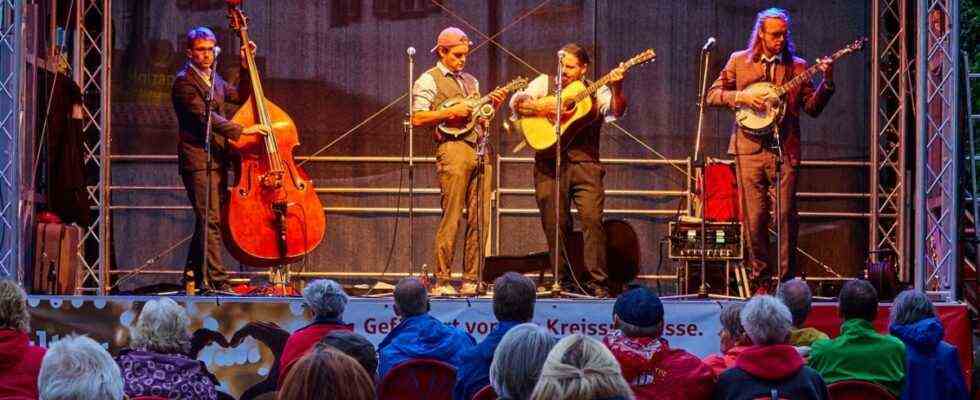Cover versions of well-known hits are one of the painful experiences of a concert-goer. Arouse the longing for the original without fulfilling it. The more deeply anchored are those rare moments in which, instead of the decal, an amazingly imaginative interpretation of the original sounds that one would like to freeze in awe – if the rhythm let one. On Saturday evening during the cultural summer on Glonn’s market square, there were three such acoustic temptations. So the four musicians planted from Johnny & the Yooahoos as a catchy tune in the bluegrass meadow: first “What is love” by Haddaway, then “Nur dream” in the dance version by Jasmin Floret Wagner and finally “The Weight” from the movie “Easy Rider”. Lo and behold: on the humus of folk and dance music, fresh, lively and colorfully blooming melodies flourished, much to the delight of an audience that was in a good mood despite the rainy weather.
How could that happen? Let’s start the research from the roots. “Bluebird” would hardly be suitable to describe a style of music. At best, “Poa pratensis” would pass as the name of an indie band. With “Bluegrass”, however, many hearts open up: Jazz fans, blues players, folk fans and friends of artistic string music are inspired by the quick-fingered variety of North American folk music, which takes its name from the shimmering blue grasses of Kentucky, one of its countries of origin. The liberating, relieving effect of the plucked string music at the end of the day is not by chance close to gospel, the good news that should give life in the fields a deeper meaning – and for people found their free voice in songs.
The passion for music like this blooms intensely in the corridors around the Glonner Schrottgalerie, in which greats of the genre have repeatedly presented themselves over the years. For the anniversary of last year, the “Schrotter” had put an appearance by Johnny & the Yooahoos on their wish list, but had to postpone it for known reasons. The music-loving gallery owners therefore did not miss the opportunity offered by the concept of the Ebersberg cultural summer, and with the help of the district and municipality they transformed the marketplace into an open-air stage and thus created exactly the environment that bluegrass needs to unfold: open sky, restrained scenery, space for the audience to move. What can be made of it is shown by the band in an exemplary manner when they force the parish church bell into their performance, as if this were the most normal thing about improvisation. Even believers had a lot of fun there.
The concert unfolds its effect on several levels. First of all, there is the pace that drives the pulse upwards. The mandolin, banjo and dobro – a guitar with a built-in mechanical amplifier – require sophisticated finger technology so that picking becomes more than a rush of speed for its own sake. Bandleader Johnny Schuhbeck and his colleagues Bernie Huber and Bastian Schuhbeck have a feel for their instruments, with which they avoid the danger of monotony and give each piece its own character – a small modulation here, a charged ritardando there. Because they are not only confident on the strings, but also with their vocal cords, the band’s sound is as palatable as a Southern Comfort: The typical three-song in ever new variations raises this bluegrass to almost a symphonic level. To which double bass player Jonas Kollenda also makes a significant contribution, as an attentive supplier for the right groove as well as as the fourth voice in the choir or as an occasional solo singer.
When choosing the titles, the Johnnys rely on their own compositions, mainly from Huber’s pen, which pay homage to bluegrass in its classic form, but at the same time integrate elements of folk rock and songwriter pop so skillfully that it has a style-forming effect. As is customary in folk music in their Upper Bavarian homeland, the four of them regularly use the given format for individual gimmicks, especially when it comes to singing. Their voices give it away and so the variations seem creative, not obsessive. The remaining three show how mature their improvisation skills are when the guitarist’s chord snaps and they play over it for a few minutes. The program is enriched by a number of references to the Stanley Brothers, Pioneers and former stars of bluegrass. The connoisseurs in the audience get their money’s worth by being able to compare with other ensembles and recordings. Judging by the applause and the cheering cheers, this comparison is in favor of the Johnnys – whereby the perseverance of around 80 rain festivals on the market square is to be seen as an emphatic sign of recognition. The comeback of the scrap gallery was good for everyone involved.

